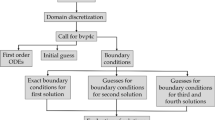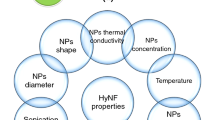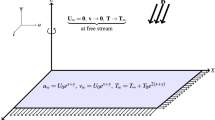Abstract
The primary aim of this study is to investigate the influence of a time-varying magnetic field on the unsteady slip flow of a ternary hybrid nanofluid over an inclined rotating disk, and to analyze the associated heat transfer mechanism. The hybrid nanofluid is composed of copper, titanium, and aluminium oxide suspended in water, serving as the base fluid. The heat transfer mechanism considered in this study comprises Joule heating and viscous dissipation. Results demonstrate that the inclusion of thermal radiation significantly enhances the heat transfer system and renders it more realistic under the effects of convection. The mathematical problem is defined by a set of non-linear partial differential equations and associated slip boundary conditions. Using a suitable similarity transformation, the proposed mathematical system is transformed into a system of nonlinear ordinary differential equations incorporating slip boundary conditions. Subsequently, the transformed equations are solved using the Homotopy Analysis Method (HAM). Graphs of the accurate results of the dimensionless velocity and temperature for various flow parameters provide a better understanding of the heat transfer characteristics of this system. It is observed that the influence of the magnetic reduces the heat transfer rate for stable non-zero slip. These findings have important implications for the design and optimization of heat transfer systems in engineering applications.










Similar content being viewed by others
Data availability
The data that has been used is confidential.
Abbreviations
- \(B_{0}\) :
-
Magnetic field \(\left( {{\text{NA}}^{ - 1} {\text{m}}^{ - 1} } \right)\)
- \(F_{0}\) :
-
Non-uniform inertia coefficient
- \(T_{\infty }\) :
-
Ambient temperature \(\left( {\text{K}} \right)\)
- \(r,z\;\&\; \varphi\) :
-
Coordinates \(\left( {\text{m}} \right)\)
- \(u,v\;\&\; w\) :
-
Velocity Components \(\left( {{\text{ms}}^{ - 1} } \right)\)
- \(F^{\prime}\left( \eta \right)\;\&\; G\left( \eta \right)\) :
-
Radial and azimuthal velocities
- \(\Theta \left( \eta \right)\) :
-
Dimensionless temperature
- \(T\) :
-
Fluid temperature \(\left( {\text{K}} \right)\)
- \(T_{{\text{w}}}\) :
-
Surface temperature
- \(q_{{\text{r}}}\) :
-
Radiation heat flux \(\left( {{\text{kgs}}^{ - 3} } \right)\)
- \(k\) :
-
Thermal conductivity \(\left( {{\text{wm}}^{ - 1} {\text{K}}^{ - 1} } \right)\)
- \(\beta_{{\text{T}}}\) :
-
Thermal expansion coefficient
- \(k_{0}\) :
-
Darcy coefficient
- \(S\) :
-
Unsteady parameter
- \(M\) :
-
Magnetic parameter
- \({\text{Re}}\) :
-
Reynold number
- \(\Pr\) :
-
Prandtl number
- \({\text{Ec}}\) :
-
Eckert number
- \(C_{{\text{F}}} \;\&\; C_{{\text{G}}}\) :
-
Skin friction
- \({\text{Nu}}\) :
-
Nusselt number
- \(\mu\) :
-
Dynamic viscosity \(\left( {{\text{kgm}}^{ - 1} {\text{s}}^{ - 1} } \right)\)
- \(\upsilon\) :
-
Kinematic viscosity \(\left( {{\text{m}}^{2} {\text{s}}^{ - 1} } \right)\)
- \(\rho\) :
-
Density \(\left( {{\text{kgm}}^{ - 3} } \right)\)
- \(\sigma\) :
-
Electrical conductivity \(\left( {{\text{sm}}^{ - 1} } \right)\)
- \(\phi\) :
-
Volume fraction nanoparticles
- \(\rho c_{{\text{p}}}\) :
-
Specific heat capacity \(\left( {{\text{jkg}}^{ - 1} {\text{K}}^{ - 1} } \right)\)
- \(\theta\) :
-
Angle
- \(\varepsilon\) :
-
Velocity slip parameter
- \(\gamma\) :
-
Thermal slip parameter
- \(\tau\) :
-
Combine Grashof and Reynold number
- \(f\) :
-
Base Fluid
- \({\text{nf}}\) :
-
Nanofluid
- \({\text{hnf}}\) :
-
Ternary hybrid nanofluid
- \({\text{thnf}}\) :
-
Hybrid nanofluid
- \(\infty\) :
-
Ambient condition
References
Choi SU, Eastman JA. Enhancing thermal conductivity of fluids with nanoparticles. Argonne National Lab.(ANL), Argonne, IL (United States); 1995.
Mohammadi M, Taheri A, Passandideh-Fard M, Sardarabadi M. Electronic chipset thermal management using a nanofluid-based mini-channel heat sink: an experimental study. Int Commun Heat Mass Transf. 2020;118:104836.
Kaya M. An experimental investigation on thermal efficiency of two-phase closed thermosyphon (TPCT) filled with CuO/water nanofluid. Eng Sci Technol Int J. 2020;23(4):812–20.
Jamshed W, Goodarzi M, Prakash M, Nisar KS, Zakarya M, Abdel-Aty AH. Evaluating the unsteady Casson nanofluid over a stretching sheet with solar thermal radiation: an optimal case study. Case Stud Thermal Eng. 2021;26:101160.
Srikanth R, Balaji C. Experimental investigation on the heat transfer performance of a PCM based pin fin heat sink with discrete heating. Int J Therm Sci. 2017;111:188–203.
Jamshed W, Nisar KS, Gowda RP, Kumar RN, Prasannakumara BC. Radiative heat transfer of second grade nanofluid flow past a porous flat surface: a single-phase mathematical model. Phys Scr. 2021;96(6):064006.
Said Z, Assad ME, Hachicha AA, Bellos E, Abdelkareem MA, Alazaizeh DZ, Yousef BA. Enhancing the performance of automotive radiators using nanofluids. Renew Sustain Energy Rev. 2019;112:183–94.
Chaji H, Ajabshirchi Y, Esmaeilzadeh E, Heris SZ, Hedayatizadeh M, Kahani M. Experimental study on thermal efficiency of flat plate solar collector using TiO2/water nanofluid. Mod Appl Sci. 2013;7(10):60–9.
Muneeshwaran M, Srinivasan G, Muthukumar P, Wang CC. Role of hybrid-nanofluid in heat transfer enhancement–a review. Int Commun Heat Mass Transf. 2021;125:105341.
Sajid MU, Ali HM. Thermal conductivity of hybrid nanofluids: a critical review. Int J Heat Mass Transf. 2018;126:211–34.
Alqarni AJ, Abo-Elkhair RE, Elsaid EM, Abdel-Aty AH, Abdel-wahed MS. Effect of magnetic force and moderate Reynolds number on MHD Jeffrey hybrid nanofluid through peristaltic channel: application of cancer treatment. Eur Phys J Plus. 2023;138(2):1–30.
Sajid T, Jamshed W, Eid MR, Altamirano GC, Aslam F, Alanzi AM, Abd-Elmonem A. Magnetized Cross tetra hybrid nanofluid passed a stenosed artery with nonuniform heat source (sink) and thermal radiation: novel tetra hybrid Tiwari and Das nanofluid model. J Magn Magn Mater. 2023;569:170443.
Kanti PK, Maiya MP. Rheology and thermal conductivity of graphene oxide and coal fly ash hybrid nanofluids for various particle mixture ratios for heat transfer applications: experimental study. Int Commun Heat Mass Transf. 2022;138:106408.
Aziz A, Jamshed W, Aziz T, Bahaidarah HM, Ur RK. Entropy analysis of Powell-Eyring hybrid nanofluid including effect of linear thermal radiation and viscous dissipation. J Therm Anal Calorim. 2021;143:1331–43.
Taherialekouhi R, Rasouli S, Khosravi A. An experimental study on stability and thermal conductivity of water-graphene oxide/aluminum oxide nanoparticles as a cooling hybrid nanofluid. Int J Heat Mass Transf. 2019;145:118751.
Ali I, Gul T, Khan A. Unsteady hydromagnetic flow over an inclined rotating disk through neural networking approach. Mathematics. 2023;11(8):1893.
Jamshed W, Nisar KS, Ibrahim RW, Mukhtar T, Vijayakumar V, Ahmad F. Computational frame work of Cattaneo-Christov heat flux effects on engine oil based williamson hybrid nanofluids: a thermal case study. Case Stud Thermal Eng. 2021;26:101179.
Islam N, Pasha AA, Jamshed W, Ibrahim RW, Alsulami R. On Powell-Eyring hybridity nanofluidic flow based Carboxy-Methyl-Cellulose (CMC) with solar thermal radiation: a quadratic regression estimation. Int Commun Heat Mass Transf. 2022;138:106413.
Hussain SM, Jamshed W. A comparative entropy based analysis of tangent hyperbolic hybrid nanofluid flow: implementing finite difference method. Int Commun Heat Mass Transf. 2021;129:105671.
Jamshed W, Devi SU, Nisar KS. Single phase based study of Ag-Cu/EO Williamson hybrid nanofluid flow over a stretching surface with shape factor. Phys Scr. 2021;96(6):065202.
Sahoo RR, Kumar V. Development of a new correlation to determine the viscosity of ternary hybrid nanofluid. Int Commun Heat Mass Transf. 2020;111:104451.
Wang J, Xu YP, Qahiti R, Jafaryar M, Alazwari MA, Abu-Hamdeh NH, Issakhov A, Selim MM. Simulation of hybrid nanofluid flow within a microchannel heat sink considering porous media analyzing CPU stability. J Petrol Sci Eng. 2022;208:109734.
Shah TR, Ali HM. Applications of hybrid nanofluids in solar energy, practical limitations and challenges: a critical review. Sol Energy. 2019;183:173–203.
Sajid T, Pasha AA, Jamshed W, Shahzad F, Eid MR, Ibrahim RW, El Din SM. Radiative and porosity effects of trihybrid Casson nanofluids with Bödewadt flow and inconstant heat source by Yamada-Ota and Xue models. Alex Eng J. 2023;66:457–73.
Kármán TV. Über laminare und turbulente Reibung. ZAMM J Appl Math Mech Zeitschrift für Angew Math Mech. 1921;1(4):233–52.
Owen JM, Roger RH. Flow and heat transfer in rotating-disc systems. Volume I-Rotor-stator systems. NASA STI/Recon Tech Rep A. 1989;90:45759.
Miklavčič M, Wang CY. The flow due to a rough rotating disk. Zeitschrift Angew Math Phys ZAMP. 2004;55:235–46.
Shahzad F, Jamshed W, Eid MR, Ibrahim RW, Aslam F, Isa SS, Guedri K. The effect of pressure gradient on MHD flow of a tri-hybrid Newtonian nanofluid in a circular channel. J Magn Magn Mater. 2023;568:170320.
Turkyilmazoglu M, Senel P. Heat and mass transfer of the flow due to a rotating rough and porous disk. Int J Therm Sci. 2013;63:146–58.
Devi SA, Devi SS. Numerical investigation of hydromagnetic hybrid Cu–Al2O3/water nanofluid flow over a permeable stretching sheet with suction. Int J Nonlinear Sci Numer Simul. 2016;17(5):249–57.
Acharya N, Maity S, Kundu PK. Entropy generation optimization of unsteady radiative hybrid nanofluid flow over a slippery spinning disk. Proc Inst Mech Eng C J Mech Eng Sci. 2022;236(11):6007–24.
Akbar NS, Khan ZH, Nadeem S. The combined effects of slip and convective boundary conditions on stagnation-point flow of CNT suspended nanofluid over a stretching sheet. J Mol Liq. 2014;196:21–5.
Turkyilmazoglu M. Multiple solutions of heat and mass transfer of MHD slip flow for the viscoelastic fluid over a stretching sheet. Int J Therm Sci. 2011;50(11):2264–76.
Nayak MK, Shaw S, Pandey VS, Chamkha AJ. Combined effects of slip and convective boundary condition on MHD 3D stretched flow of nanofluid through porous media inspired by non-linear thermal radiation. Indian J Phys. 2018;92:1017–28.
Zhang JK, Dong H, Zhou EZ, Li BW, Tian XY. A combined method for solving 2D incompressible flow and heat transfer by spectral collocation method and artificial compressibility method. Int J Heat Mass Transf. 2017;112:289–99.
Nayak MK. Chemical reaction effect on MHD viscoelastic fluid over a stretching sheet through porous medium. Meccanica. 2016;51(8):1699–711.
Ganga B, Ansari SM, Ganesh NV, Hakeem AA. MHD flow of Boungiorno model nanofluid over a vertical plate with internal heat generation/absorption. Propuls Power Res. 2016;5(3):211–22.
Hayat T, Javed M, Imtiaz M, Alsaedi A. Convective flow of Jeffrey nanofluid due to two stretchable rotating disks. J Mol Liq. 2017;240:291–302.
Deng YJ, Huang GJ, Cao LF, Wu XD, Huang L. Effect of ageing temperature on precipitation of Al-Cu-Li-Mn-Zr alloy. J Cent South Univ. 2018;25(6):1340–9.
Ibrahim SM, Lorenzini G, Kumar PV, Raju CS. Influence of chemical reaction and heat source on dissipative MHD mixed convection flow of a Casson nanofluid over a nonlinear permeable stretching sheet. Int J Heat Mass Transf. 2017;111:346–55.
Thumma T, Bég OA, Kadir A. Numerical study of heat source/sink effects on dissipative magnetic nanofluid flow from a non-linear inclined stretching/shrinking sheet. J Mol Liq. 2017;232:159–73.
Sajid T, Ayub A, Shah SZ, Jamshed W, Eid MR, El Din ES, Irfan R, Hussain SM. Trace of chemical reactions accompanied with arrhenius energy on ternary hybridity nanofluid past a wedge. Symmetry. 2022;14(9):1850.
Umavathi JC, Bég OA. Computation of von Karman thermo-solutal swirling flow of a nanofluid over a rotating disk to a non-Darcian porous medium with hydrodynamic/thermal slip. J Thermal Anal Calorim. 2021;147:1–6.
Waqas H, Imran M, Muhammad T, Sait SM, Ellahi R. Numerical investigation on bioconvection flow of Oldroyd-B nanofluid with nonlinear thermal radiation and motile microorganisms over rotating disk. J Therm Anal Calorim. 2021;145:523–39.
Aladdin NA, Bachok N, Pop I. Cu-Al2O3/water hybrid nanofluid flow over a permeable moving surface in presence of hydromagnetic and suction effects. Alex Eng J. 2020;59(2):657–66.
Khan MI, Waqas H, Khan SU, Imran M, Chu YM, Abbasi A, Kadry S. Slip flow of micropolar nanofluid over a porous rotating disk with motile microorganisms, nonlinear thermal radiation and activation energy. Int Commun Heat Mass Transf. 2021;122:105161.
Ramzan M, Riasat S, Chung JD, Chu YM, Sheikholeslami M, Kadry S, Howari F. Upshot of heterogeneous catalysis in a nanofluid flow over a rotating disk with slip effects and Entropy optimization analysis. Sci Rep. 2021;11(1):120.
Liao S. Beyond perturbation: introduction to the homotopy analysis method. Boca Raton: CRC Press; 2003.
Mustafa M. MHD nanofluid flow over a rotating disk with partial slip effects: buongiorno model. Int J Heat Mass Transf. 2017;108:1910–6.
Aziz A, Alsaedi A, Muhammad T, Hayat T. Numerical study for heat generation/absorption in flow of nanofluid by a rotating disk. Results Phys. 2018;8:785–92.
Acknowledgements
This work is partially funded by the Future university in egypt engineering research project 2023.
Author information
Authors and Affiliations
Corresponding author
Ethics declarations
Conflict of interest
The authors affirm that they have no known financial or interpersonal conflicts that would have seemed to have an impact on the research presented in this study.
Additional information
Publisher's Note
Springer Nature remains neutral with regard to jurisdictional claims in published maps and institutional affiliations.
Rights and permissions
Springer Nature or its licensor (e.g. a society or other partner) holds exclusive rights to this article under a publishing agreement with the author(s) or other rightsholder(s); author self-archiving of the accepted manuscript version of this article is solely governed by the terms of such publishing agreement and applicable law.
About this article
Cite this article
Usman, M., Areshi, M., Khan, N. et al. Revolutionizing heat transfer: exploring ternary hybrid nanofluid slip flow on an inclined rotating disk with thermal radiation and viscous dissipation effects. J Therm Anal Calorim 148, 9131–9144 (2023). https://doi.org/10.1007/s10973-023-12299-7
Received:
Accepted:
Published:
Issue Date:
DOI: https://doi.org/10.1007/s10973-023-12299-7




